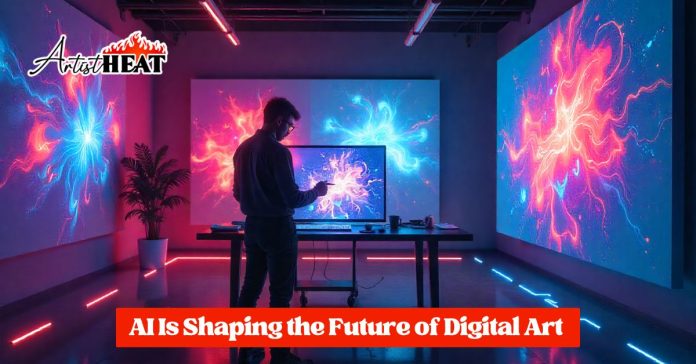The art world has always been a space of revolution, but nothing quite prepared us for the seismic shift we’re witnessing right now. How AI is shaping the future of digital art in 2025 isn’t just a trendy conversation starter at gallery openings anymore – it is the reality that is redefining what it means to be creative in hyper-connected world.
The feeling of being in a sci-fi movie is something that happens whenever you walk into any contemporary art exhibition these days. Instead of the traditional canvases and sculptures, we now have interactive installations, react to our moves, the real-time developing paintings, and even the art that appears to have artificially intelligent life. It is not a far-fetched idea of the future, this is actually what is going on and it is insane.
The Creative Revolution Nobody Saw Coming
Let’s face it – when AI art generators came along for the first time most old-school artists seriously squinted so hard they probably saw out their brain stems. “This isn’t genuine art,” they told. “Machines can’t be imaginative,” they were saying. Well, plot twist: how AI is shaping the future of digital art in 2025 has proven that creativity isn’t exclusively human territory anymore.
Performing artists, such as Refik Anadol, have been playing in this Sandbox over several years and can use machine learning programs to create riveting visual behaviors with data. His so-called Machine Hallucinations series is not only pretty to look at; it tries to redefine our basic perception of what art can — and should be. Next comes Mario Klingemann who has been touted as the father of artificial intelligence art so his portraits, which are born out of the virtual void, are hauntingly human.
All that is well and good but here is where it gets fascinating (and sort of frightening): they are not just novelty acts any more. Major Auction Houses auction AI-based artworks over hundreds-thousand of dollars. This is a technology that even the art market, which is usually slower to change than even a government web site, is catching up on at a higher rate than attempting to predict.
The Tools That Are Changing Everything
The AI art is also democratized, which has been nothing less than revolutionary. Creative tools such as Midjourney, DALL-E 3, and Stable Diffusion have enabled literally anyone who has access to the internet with an online connection to possess high quality professional creative ability. Now your illiterate neighbor can draw something resembling a stick figure, but all of a sudden he or she begins to paint surrealistic masterpieces that would turn Salvador Dal in his grave.
How AI is shaping the future of digital art in 2026 extends far beyond simple image generation, though. We are experiencing the emergence of AI tools that can bring inanimate objects to life, develop interactive 3 – dimensional space, and even generate unique soundscape to pair with visual artwork. The demarcations that exist among the various artistic mediums are melting as is an ice cream on a hot road.
These tools are not seen as disturbing the traditional skills of artists, but an addition with such artists as Helena Sarin. She blends what the AI creates with hand-painted works to form the hybrid results that would not have been possible without human sense and AI learning tools.
The Great Collaboration Experiment
It is igniting the alteration in the concept of authorship, which is perhaps one of the most intriguing features of this digital art revolution. When an artist applies AI to come up with the initial concept and then alters and modifies it to a final product by applying traditional digital art methods, who is projected to be the maker? It is similar to wondering who gets credit a perfectly diced onion, the cook or his knife?
The response, in more and more cases, is yes. How AI is shaping the future of digital art in 2025 is revealing that the most compelling works emerge from human-AI collaboration rather than replacement. Artists such as Memo Akten are using AI as a collaborator, supplying it with data sets and controlling its production and output but making room to uncover imagery and workings that purely human intention could never uncover.
New and whole new art forms are emerging in this collaborative process. Learning interactive artwork prompted by the way people behave, ever-changing generative art experiences and tailored artwork experiences that change according to how people choose them is ready to become the standard and not the anomaly anymore.
The Uncomfortable Truths We Need to Address
No need to beat around the bush, the emergence of AI in digital art has not been only about rainbow unicorns and revolutionary breakthroughs. However there are some very uncomfortable questions that we have to wrestle with and going away and acting like questions do not exist is not going to make them vanish.
To begin with, there is the elephant in the room, i.e., job displacement. The question is, when programs will allow the creation of professional-grade illustrations in a matter of minutes, what becomes of the legions of artists that have dedicated their many years to their art? The answer isn’t simple, but how AI is shaping the future of digital art in 2025 suggests that adaptation, rather than resistance, might be the key to survival.
Then there is such a prickly problem as training data. The Vast majority of AI art generators have been trained using millions of images scraped off the internet, usually with neither the permission nor compensation of the original artists. It is like photocopying somebody else homework, making slight modifications on their words and strating to think that it is his/her original piece of work. The court wars have only just started and the results will probably redefine our thinking about intellectual property in a digital era.
The Economic Earthquake
The financial implications of AI art are staggering and complex. On one hand, how AI is shaping the future of digital art in 2026 is democratizing art creation, allowing people without traditional training or expensive equipment to produce and sell artwork. Sites such as Foundation, SuperRare, and KnownOrigin are awash with computer generated work with hefty prices attached.
Conversely, this democratization has led to the market becoming saturated by content, and consequently, it would be harder to make another single artist be heard in the market. It can be compared to the fact that everyone can obtain access to professional photography gear, it is technically advanced, but it overwhelmingly floods the market.
Clever artists are discovering how to embrace the power of AI as an aid as opposed to a prop. They are using AI to prototype quickly, experiment in directions they would otherwise not have, and to manage the more routine jobs that allow them to get on with the more conceptual and emotional foundations of their work which machines have yet to have mastered.
The Authenticity Paradox
This is what I worry about at night: how will anyone know what art is real in the world where we can easily copy any artistic styles? Once you can crank out a painting that, technically, is better than anything actually painted by Van Gogh, himself, then we have to question some rather profound notions of value and originality.
How AI is shaping the future of digital art in 2026 is pushing us toward a new definition of authenticity – the one that accords a matter of more importance to the vision of the artist and his emotional purpose than to his technical performance. The most successful AI-helped artists do not aim to imitate the existing styles; they learn to work through AI to create whole new visual languages that would be impossible without machine learning.
Artists such as Sondra Perry are employing AI in order to advance themes of identity, technology, and cultural representation in a manner that was unachievable through the simple use of traditional media alone. Their collaborations show that authenticity in the AI era does not imply renouncing of technologies, but on the contrary embracing their possibilities and using them to reflect real human feelings and viewpoints.
Looking Forward: What’s Next?
The trajectory of how AI is shaping the future of digital art in 2025 points toward even more radical transformations ahead. We are at the edge of self-aware AI with models that recognize and react to emotional context, can create pieces of art that react to real time events, and the so-called immersive experiences that penetrate into the blur between art, entertainment and the real world.
The embedding of virtual and reality is providing new surfaces of AI-generated art. Consider a forest made entirely out of AI-generated sculpture trees that would all react to your entering, or going to a concert where the visual accompaniment would be an AI listening to the music and the people and creating visuals to the sound, to your reactions, in real-time.
Innovation in the next wave will therefore be aimed at making AI tools more human like and touchy. Artists could soon speak to their computers in gestures, emotions or even by direct neural interfaces rather than type prompts. It is a science fiction, but since this field is moving as it is, perhaps it will not be so long before this becomes a reality.
What lies ahead in digital art is not man verses machine, but is man and machine doing things that were not possible with man alone or machine alone. And honestly? That future is absolutely amazing as far as I am concerned. As an art lover and/or someone fascinated with the shifting before your eyes, or as an artist tired of having your decisions dictated by those with an MBA more than an MFA, we are living in one of those moments in history that will forever be discussed as some form of inflection point in the way human beings are creative. There is no limit to the canvas, the tools change everyday and the only boundary is our imagination.

